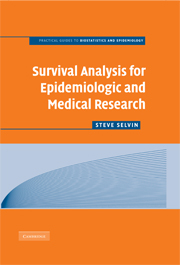Book contents
- Frontmatter
- Contents
- Overview
- 1 Rates and their properties
- 2 Life tables
- 3 Two especially useful estimation tools
- 4 Product-limit estimation
- 5 Exponential survival time probability distribution
- 6 Weibull survival time probability distribution
- 7 Analysis of two-sample survival data
- 8 General hazards model: parametric
- 9 General hazards model: nonparametric
- Examples of R
- Data
- Problem set
- References
- Index
4 - Product-limit estimation
Published online by Cambridge University Press: 03 February 2010
- Frontmatter
- Contents
- Overview
- 1 Rates and their properties
- 2 Life tables
- 3 Two especially useful estimation tools
- 4 Product-limit estimation
- 5 Exponential survival time probability distribution
- 6 Weibull survival time probability distribution
- 7 Analysis of two-sample survival data
- 8 General hazards model: parametric
- 9 General hazards model: nonparametric
- Examples of R
- Data
- Problem set
- References
- Index
Summary
Summary values are at the heart of statistical analysis. Similarly, the estimation of survival probabilities and hazard rates is at the center of summarizing survival data. As might be imagined, a number of ways exist to estimate these two fundamental statistical summaries of survival experience.
To start, suppose a sample consists of n independent, unique, and complete survival times. Unique means that all sampled survival times are different. Complete means that all survival times end in an observed outcome such as death. For example, consider the unique and complete survival times of 10 (n = 10) extremely ill AIDS patients:
survival times (in days): 2, 72, 51, 60, 33, 27, 14, 24, 4, and 21.
A simple and direct estimate of a survival probability begins with calculating the conditional probability that an individual dies within a specific time interval. Among several ways to create these intervals, one is based on the time of death. Each interval is defined so that it contains only one death. In this case, the interval limits are constructed from survival times (denoted ti). Unlike constructing a life table, the interval lengths vary and are determined by observed values. For the example AIDS data, a sequence of 10 such intervals (denoted ti-1 to ti) is given in Table 4.1 (second column). For example, the sixth interval t5 to t6 is 24 days to 27 days (i = 6) and, like all 10 intervals, contains one death.
- Type
- Chapter
- Information
- Survival Analysis for Epidemiologic and Medical Research , pp. 68 - 89Publisher: Cambridge University PressPrint publication year: 2008



